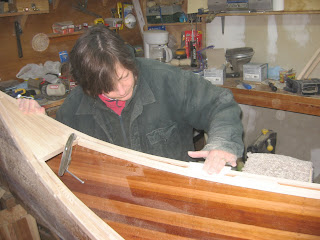The outer gunnel was attached using 1 1/2" screws that were countersunk. We will make plugs to fill the holes later. The plugged screw holes add to the overall athestic of the canoe. The final sanding on the top side of the gunnel was done by hand, as is all the finishing sanding.
 After using cabinet scrapers to remove any runs in the epoxy in the interior of the canoe, it was sanded smooth. At least one more coat of epoxy will be applied to create a perfectly smooth surface.
After using cabinet scrapers to remove any runs in the epoxy in the interior of the canoe, it was sanded smooth. At least one more coat of epoxy will be applied to create a perfectly smooth surface.

























